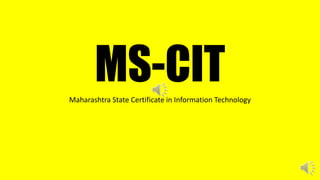
MS-CIT.pptx
- 1. MS-CIT Maharashtra State Certificate in Information Technology
- 2. MS-CIT CERTIFICATE • ERA (E-Learning Revolution to All) • Internal Marks = Total 50 • For Eligible Final Exam = Required 20 Marks and 40 Sessions Completed • Final Exam • Objectives =15 Marks (Passing 6 Marks) • Practical Questions = 35 Marks (Passing 14 Marks) • Total 50 Marks (Passing 20 Marks)
- 3. Chapter 1: Information Technology, the Internet, and you • Information Systems: • People- we all who use Computer are end users. • Procedure- The rules or guidelines • Software- A program is a step-by-step instruction Software is used to convert data (unprocessed facts) into information (processed facts) • Hardware- The equipment like smartphones, tablets, keyboards, mouse, displays, system units, etc. Hardware is controlled by software • Data- the raw, unprocessed facts like text, numbers, images, sound, etc • Internet-International network of computers
- 4. People • The most important part of any information system.
- 5. Software • Software is another name for a program. • Two major kinds of software • System Software • Application Software
- 6. System Software • System Software is not a single program, it is a collection of programs. • Operating System - coordinates computer resources, provide an interface between user and computer, and run applications. Types of Operating System:- • Embedded OS (Real-time OS) • Standalone OS • Network OS • Utilities perform specific tasks • Device Drivers are specialized programs designed to allowed all devices to communicate with rest of computer system.
- 7. Application Software • Also known as End user software Three categories of application software • General Purpose applications – browsers, Word, Excel, PowerPoint • Specialised applications – Tally, Photoshop, CorelDraw, AutoCAD • Mobile apps – Gpay, WhatsApp, QR Scanner, Translate
- 8. Guess the application category
- 9. Hardware • Computers are electronics devices that can follow instructions to accept input, process that input, and produce information.
- 10. Types of Computer • Personal Computers (PC’s) – Least powerful, Most widely used, fastest growing type of computer. 1. Desktop 2. Laptop (Notebook) 3. Tablets 4. Smart phones 5. Wearable devices – Apple’s Watch
- 11. • Super Computers – the most powerful type of computer, used by very large organisations, used to store and process massive amounts of data • IBM’s Blue Gene • CDAC’s PARAM Types of Computer
- 12. • Mainframe Computers – Used by Insurance Companies to store information about millions of policyholders. • Not as powerful as supercomputer Types of Computer
- 13. • Midrange Computers – Used by midsized companies or departments of large companies Types of Computer
- 14. Personal Computer Hardware • System Units – is a container that houses most electronic components Two important components of system Unit are microprocessor and memory Types of Memory: • RAM • ROM
- 15. • Input / Output devices – • Input Devices – translate data • Keyboard, mouse, etc. • Output Devices – translate processed information • Monitor, Printer, etc. Personal Computer Hardware
- 16. • Secondary Storage – Unlike memory, hold data and programs even after electric power to the computer system has been turned off. • Hard disks, pen drives, removable hard disks, solid-state storage, and optical discs • Hard disks – store very large data files • Solid-state storage – does not have moving parts • Optical Discs – use laser technology, CDs, DVDs, and Blu-ray discs • Pen drives – portable data storage Personal Computer Hardware
- 17. • Communication Devices – communicate to other computer system. • Modem – is widely used communication device Personal Computer Hardware
- 18. Data • Data is raw, unprocessed facts • Document files – created by word processors • Worksheet files – created by electronic spreadsheets • Database files – created by database management programs • Presentation files – created by presentation graphics
- 19. Connectivity and Mobile Internet • Connectivity is the capability of your personal computer to share information with other computers. • Central to the concept of connectivity is the network. • A Network is a communication system connecting two or more computers. • The largest network in the world is Internet.
- 20. • Cloud Computing – uses the internet and web to shift many computer activities from a user’s computer to computers on the internet. • Wireless Communication – tablets, smartphones, and wearable devices • Internet of Things (IoT) – that allowed everyday objects embedded with electronic devices to send and receive data over the Internet.